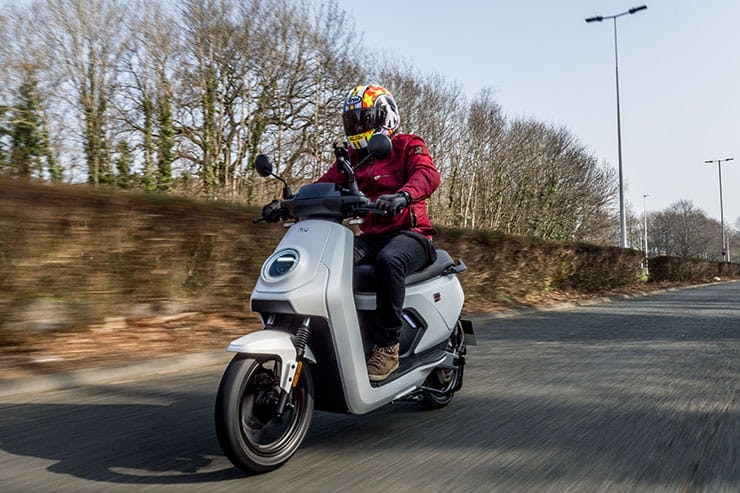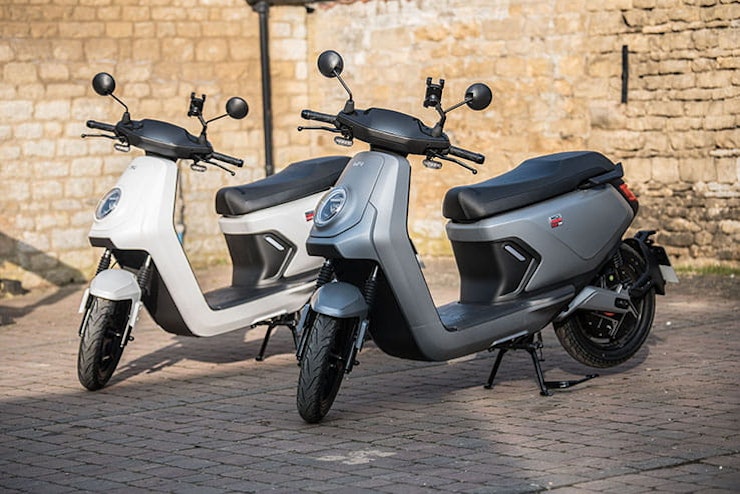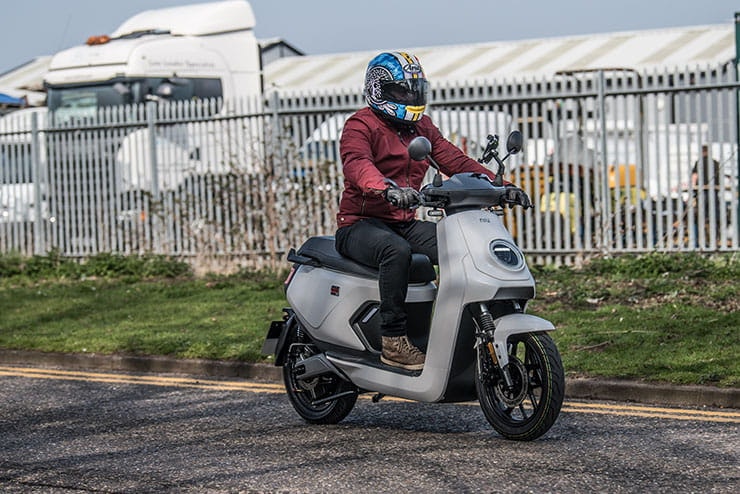NIU MQi GT EVO (2022) - Review
BikeSocial Road Tester
13.04.2022
Fully electric superbikes may grab the headlines but they aren’t comparable to their petrol equivalents in terms of range:price:weight ratio, not yet anyway. It’s the same story for adventure or touring bikes, but scooters, especially low capacity 125 machines, are a viable alternative, comparable in speed, price, and practicality – which is why so many electric scooters are now emerging onto the market, and their popularity is underlined by the 139% growth in new electric scooter registrations year-on-year (from the MCIA data, March 2022).
NIU is not new to producing electric scooters with the MQi GT EVO as the latest machine from the Chinese manufacturer. NIU claims the EVO is the fastest and sportiest in class, powered by a 500w motor, with a claimed top speed of 100kph/62mph. It also features a full-colour dash with Bluetooth connectivity, three riding modes, linked brakes, and even cruise control – yes, cruise control. We spent the day riding the EVO to see if the NIU lived up to the manufacturer’s bold claims.
Possibly the quickest in class
Nice informative dash
Strong linked brakes
Limited under-seat storage
Centre stand spring is loose
Lack of ground clearance
REVIEW: NIU MQi GT Evo (2022)
Chad tests the sportiest electric scooter in this class, able to compete with 125cc petrol machines.
NIU MQi GT EVO (2022) Price
How much is the 2022 NIU MQi GT EVO? £4099
Opting for electric isn’t as expensive as you might think. The new, 2022 NIU MQi GT starts at £4099, or, with a £250 deposit, just £88.13 per month on PCP. Either way, that is inexpensive motoring.
Arguably the nearest competition to the NIU is the SEAT MO – yes, the car people. It’s an all-electric 125cc equivalent priced at £5800 or £95 per month on PCP. So more expensive but with a (quoted) greater range of 85 miles compared to 46 miles on the NIU.
Vespa has the Elettrica which, with a 45mph top speed, is slower and closer to a 100cc equivalent as well as more expensive at £6300, while Yamaha has the 50cc equivalent NEO at £3005. Looking across the petrol market, Honda’s best-selling PCX125 is cheaper at £3549, but you will have to pay for fuel.
Power and Torque
The NIU is powered by a 72v, 5kw motor, using the fourth generation NIU lithium battery, which is claimed to push the top speed to a claimed 100kph/62mph. NIU also claim a charging time of five hours from a normal three-pin socket and a range of 75km, or 46 miles, but this depends on the conditions and how and where you ride. Unfortunately, there is no fast charger option.
The MQi GT EVO comes with three changeable rider modes: Eco, Dynamic, and Sport. ECO, as you’d expect, extends the range but limits the speed to 45kph (28mph). Dynamic limits the speed to 75kph or 47mph, and Sport delivers the full 100kph or 62mph.
Powertrain
No gearbox, no exhaust… just twist and go in almost perfect silence. Keyless ignition on, accompanied by a ping noise that sounds like an old amusement arcade game. You also get a similar ping when the indicators are activated, but otherwise it’s silent.
So far, it’s like a conventional twist-and-go petrol scooter, except there is no clutch lag, and the power is instant. It takes a few hundred yards to get used to – but it’s not too snatchy, just unusual if you’ve never ridden an electric two-wheeler before.
ECO mode is good for near-as-dammit 30mph, like a 50cc moped basically. There is no rev limiter as you’d have on a conventional petrol bike; instead, it simply stops accelerating. This is fine for the town, especially when there are lots of speed cameras, as it’s impossible to speed. Switch to Dynamic mode and you are limited to an indicated 50mph, and this is the mode to which I gravitated for the majority of the ride. It’s only on the dual carriageway that full Sport mode comes into play. It’s simple and easy to change between the modes and can easily be done whilst riding.
Out of town the MQi GT EVO certainly lives up to NIU’s bold claims. With the rider sitting upright it will reach indicated 60mph in decent time, then crawls up to 65mph-ish. Transformed into a teenager, with the chin of my crash helmet resting on the dash, I managed an indicated 70mph! That’s impressive for an electric 125cc equivalent scooter and should put it top of the speed charts for electric scooters.
Handling, Suspension, and Weight
The batteries are located under the seat and are responsible for much of the EVO’s 128kg weight. That figure is comparable to a conventional petrol scooter, like Honda’s best-selling PCX 125 (130kg fully fuelled), but heavier than Honda’s basic SH MODE 125 (118 kg). But the NIU manages its weight well, the basic but capable suspension taking everything you can throw at it. The ride quality is above average for a £4k scooter, and smoother than some of the competition.
You feel those kilos but they are not a hindrance; you can slalom through traffic with electric ease and efficiency. The only downside is the lack of ground clearance, especially on the left side, which is hampered by the protruding arm to the centre stand. The spring that holds the centre stand in place looks like it’s fallen out of a Christmas cracker and isn’t strong enough. This leads to two problems. Firstly, on bumpy roads or over speed humps the centre stand clatters against the bike, making a noise more noticeable than normal due to the lack of engine noise.
Secondly, the stand scrapes all too easily on left-handers, as the centre stand bounces around on its weak spring. Even on smooth corners, it’s relatively easy to hear a scraping noise from the left side, and occasionally, if ridden hard, on the right side too. The poor spring on my bike’s centre stand might have been a one-off but, even so, the ground clearance is limited on the left side.
NIU MQi GT EVO (2022) Comfort and Economy
Comfort from the wide seat is impressive for both rider and pillion, though perhaps not a priority on a bike with a range of just 46 miles. The full-colour dash is informative with some nice little touches like a fun speed graphic, a large range indicator and ‘percentage remaining’ on the left side, speedo in the middle, and other information like the time and trip on the right side. The switchgear is simple and straightforward. Cruise control is a quirky but neat touch, too; simply press the button and it’s activated (although there is no way to increase or decrease the speed but it does come in useful when cruising between average speed cameras).
As you’d expect in today’s world, Bluetooth connectivity allows you to see the range, change modes or even check the tyre pressures. Each valve has a QR code that interacts with the specific NIU app – so all very clever.
NIU claims a maximum range of 46 miles, but I think they are being a little conservative. I did a round trip of 34 miles, including some very short stints on the dual carriageway at 60 to 65mph, and at the end of my test ride still had 40% battery and 22 miles remaining. In theory that would mean 56 before the battery was done, or 45-50miles before panic set in.
A re-charge takes up to five hours from a conventional three-pin socket, which most customers will do overnight or during the day at work, and there is no fast charger option. You can, however, charge the bike with the batteries under the seat or remove both batteries and carry them into the office/home/garage and charge remotely. The battery is easy to access from under the seat, and easy to remove but, at 14 kilos each, are not light.
While battery access is good, there is a significant disadvantage of locating them under the seat: a serious lack of storage compared to other scooters – in fact, not even enough room for one open-face helmet. There is enough space for a jacket or waterproofs or a small bag, and for some that will be enough. But for me, this oversight tarnishes an otherwise capable commuter.
Brakes
The NIU doesn’t have any rider aids, including ABS and traction control, which puts it on a par with some of the electric competition. The brakes, though, are impressive for this type of bike with the front stopper operating the front disc only, and the linked rear activating both front and rear. For 90% of the test, I only used the linked rear brake, which almost makes the front lever redundant. The only downside is the levers are not span adjustable, something I was expecting on a 125cc equivalent scooter aimed at young and female riders.
Rider Aids, Extra Equipment and Accessories
As mentioned, the EVO carries no rider aids and just three riding modes which limit the drive. Our test bike was fitted with the NIU phone holder (£29.99) and, for those requiring storage for helmets, there is an optional top box (£144.99). That NIU app is free to download and certainly worth having, but the tyre monitors will be £35.99
NIU MQi GT EVO (2022) Rivals
Super Soco is taking on the sales charts with aplomb but it’s not the only lightweight electric scooter on the market, here’s a selection of the nearest to the NIU.
Power: 4.8bhp / 3.6kw
Torque: 147lbft / 200Nm
Weight: 130kg
Price: £6305
SEAT MO:
Power: 9.4 bhp / 7kw
Torque: 177ftlb / 240Nm
Weight: 152kg
Price: £5800
Power: 12.3bhp / 9.2Kw
Torque: 8.7ftlb / 11.8Nm
Weight: 130kg
Price: £3549
Power: 3.5bhp / 2.4kw
Torque: 100ftlb / 136Nm
Weight: 90kg
Price: £3005
NIU MQi GT EVO (2022) Verdict
I was unsure what to expect from a £4K electric scooter. In some ways I’m impressed and in others a little disappointed as the MQi GT EVO is so close to being excellent. Its speed, performance, comfort, ride quality and handling are all good. NIU claims this is the fastest bike in this electric class, and I provisionally agree (without performance testing each bike we can’t categorically confirm). The brakes are strong, the customisable dash informative, modern and stylish, while the tested range of 45-50 miles should be more than enough for most scooter commutes.
However, I can’t ignore the lack of under-seat storage, which for me is a drawback for a scooter. The lack of ground clearance is also a niggle, but I guess that depends on how and where you ride. For £4000, or less than £90 a month on PCP that is cheap motorcycling on a nippy, good looking machine with nice brakes. But you’ll need to add a top box if you want to store your helmet.
NIU MQi GT EVO (2022) TECHNICAL SPECIFICATION
Looking for scooter or moped insurance? Get a quote for this machine with Bennetts moped and scooter insurance
MCIA Secured gives bike buyers the chance to see just how much work a manufacturer has put into making their new investment as resistant to theft as possible.
As we all know, the more security you use, the less chance there is of your bike being stolen. In fact, based on research by Bennetts, using a disc lock makes your machine three times less likely to be stolen, while heavy duty kit can make it less likely to be stolen than a car. For reviews of the best security products, click here.
MCIA Secured gives motorcycles a rating out of five stars, based on the following being fitted to a new bike as standard:
A steering lock that meets the UNECE 62 standard
An ignition immobiliser system
A vehicle marking system
An alarm system
A vehicle tracking system with subscription
The higher the star rating, the better the security, so always ask your dealer what rating your bike has, and compare it to other machines on your shortlist.


